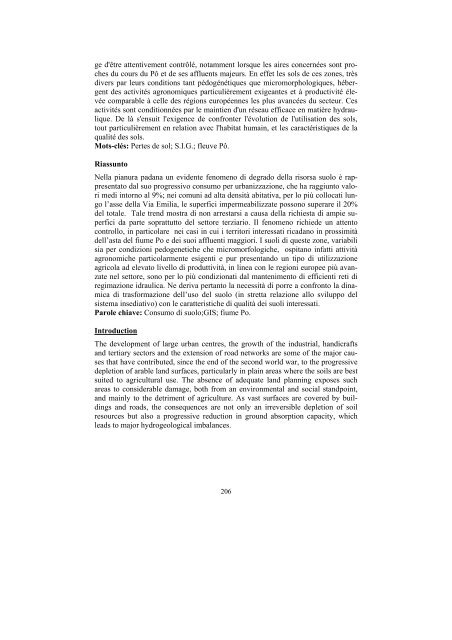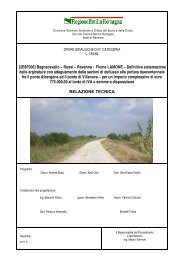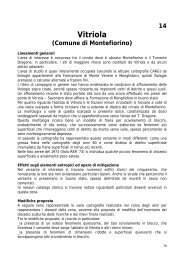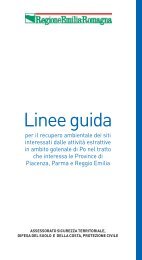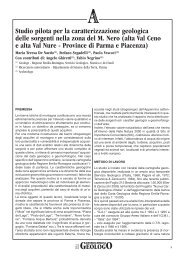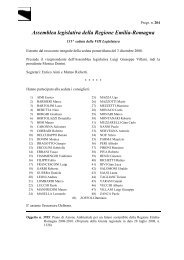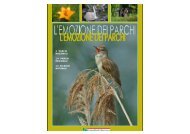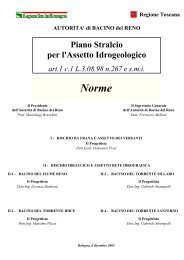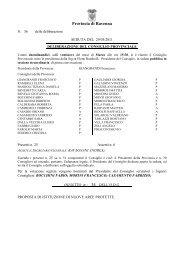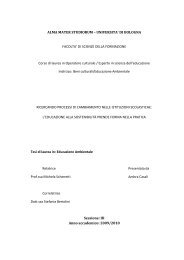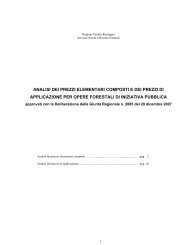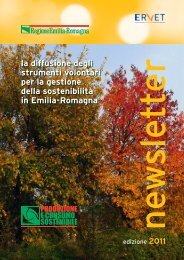air, water and soil quality qualité - ER Ambiente - Regione Emilia ...
air, water and soil quality qualité - ER Ambiente - Regione Emilia ...
air, water and soil quality qualité - ER Ambiente - Regione Emilia ...
Create successful ePaper yourself
Turn your PDF publications into a flip-book with our unique Google optimized e-Paper software.
ge d'être attentivement contrôlé, notamment lorsque les <strong>air</strong>es concernées sont proches<br />
du cours du Pô et de ses affluents majeurs. En effet les sols de ces zones, très<br />
divers par leurs conditions tant pédogénétiques que micromorphologiques, hébergent<br />
des activités agronomiques particulièrement exigeantes et à productivité élevée<br />
comparable à celle des régions européennes les plus avancées du secteur. Ces<br />
activités sont conditionnées par le maintien d'un réseau efficace en matière hydraulique.<br />
De là s'ensuit l'exigence de confronter l'évolution de l'utilisation des sols,<br />
tout particulièrement en relation avec l'habitat humain, et les caractéristiques de la<br />
<strong>qualité</strong> des sols.<br />
Mots-clés: Pertes de sol; S.I.G.; fleuve Pô.<br />
Riassunto<br />
Nella pianura padana un evidente fenomeno di degrado della risorsa suolo è rappresentato<br />
dal suo progressivo consumo per urbanizzazione, che ha raggiunto valori<br />
medi intorno al 9%; nei comuni ad alta densità abitativa, per lo più collocati lungo<br />
l’asse della Via <strong>Emilia</strong>, le superfici impermeabilizzate possono superare il 20%<br />
del totale. Tale trend mostra di non arrestarsi a causa della richiesta di ampie superfici<br />
da parte soprattutto del settore terziario. Il fenomeno richiede un attento<br />
controllo, in particolare nei casi in cui i territori interessati ricadano in prossimità<br />
dell’asta del fiume Po e dei suoi affluenti maggiori. I suoli di queste zone, variabili<br />
sia per condizioni pedogenetiche che micromorfologiche, ospitano infatti attività<br />
agronomiche particolarmente esigenti e pur present<strong>and</strong>o un tipo di utilizzazione<br />
agricola ad elevato livello di produttività, in linea con le regioni europee più avanzate<br />
nel settore, sono per lo più condizionati dal mantenimento di efficienti reti di<br />
regimazione idraulica. Ne deriva pertanto la necessità di porre a confronto la dinamica<br />
di trasformazione dell’uso del suolo (in stretta relazione allo sviluppo del<br />
sistema insediativo) con le caratteristiche di qualità dei suoli interessati.<br />
Parole chiave: Consumo di suolo;GIS; fiume Po.<br />
Introduction<br />
The development of large urban centres, the growth of the industrial, h<strong>and</strong>icrafts<br />
<strong>and</strong> tertiary sectors <strong>and</strong> the extension of road networks are some of the major causes<br />
that have contributed, since the end of the second world war, to the progressive<br />
depletion of arable l<strong>and</strong> surfaces, particularly in plain areas where the <strong>soil</strong>s are best<br />
suited to agricultural use. The absence of adequate l<strong>and</strong> planning exposes such<br />
areas to considerable damage, both from an environmental <strong>and</strong> social st<strong>and</strong>point,<br />
<strong>and</strong> mainly to the detriment of agriculture. As vast surfaces are covered by buildings<br />
<strong>and</strong> roads, the consequences are not only an irreversible depletion of <strong>soil</strong><br />
resources but also a progressive reduction in ground absorption capacity, which<br />
leads to major hydrogeological imbalances.<br />
206


